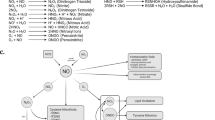Summary.
This overview summarizes recent findings on the role of tyrosyl radical (TyrO•) in the multitudinous neurochemical systems of brain, and theorizes on the putative role of TyrO• in neurological disorders [Parkinson's disease (PD), Alzheimer's disease (AD) and amyotrophic lateral sclerosis (ALS)]. TyrO• and tyrosine per se can interact with reactive oxygen species (ROS) and reactive nitrogen species (RNS) via radical mechanisms and chain propagating reactions. The concentration of TyrO•, ROS and RNS can increase dramatically under conditions of generalized stress: oxidative, nitrative or reductive as well, and this can induce damage directly (by lipid peroxidation) or indirectly (by proteins oxidation and/or nitration), potentially causing apoptotic neuronal cell death or autoschizis.
Evidence of lesion-induced neuronal oxidative stress includes the presence of protein peroxides (TyrOOH), DT (o,o'-dityrosine) and 3-NT (3-nitrotyrosine). Mechanistic details of protein- and enzymatic oxidation/nitration in vivo remain unresolved, although recent in vitro data strongly implicate free radical pathways via TyrO•. Nitration/denitration processes can be pathological, but they also may play: 1) a signal transduction role, because nitration of tyrosine residues through TyrO• formation can modulate, as well the phosphorylation (tyrosine kinases activity) and/or tyrosine hydroxylation (tyrosine hydroxylase inactivation), leading to consequent dopamine synthesis failure and increased degradation of target proteins, respectively; 2) a role of “blocker” for radical-radical reactions (scavenging of NO•, NO• 2 and CO3 •− by TyrO•); 3) a role of limiting factors for peroxynitrite formation, by lowering O2 •− formation, which is strongly linked to the pathogenesis of neural diseases.
It is still not known if tyrosine oxidation/nitration via TyrO• formation is 1) a footprint of generalized stress and neuronal disorders, or 2) an important part of O2 •− and NO• metabolism, or 3) merely a part of integral processes for maintaining of neuronal homeostasis. The full answer to these questions should be of top research priority, as the problem of increased free radical formation in brain and/or imbalance of the ratios ROS/RNS/TyrO• may be all important in defining whether oxidative stress is the critical determinant of tissue and neural cell injury that leads to pathological end-points.
Similar content being viewed by others
Author information
Authors and Affiliations
Additional information
Received June 28, 2001 Accepted August 6, 2001 Published online June 17, 2002
Rights and permissions
About this article
Cite this article
Kochman, A., Kośka, C. & Metodiewa, D. Submolecular adventures of brain tyrosine: what are we searching for now?. Amino Acids 23, 95–101 (2002). https://doi.org/10.1007/s00726-001-0114-6
Issue Date:
DOI: https://doi.org/10.1007/s00726-001-0114-6




